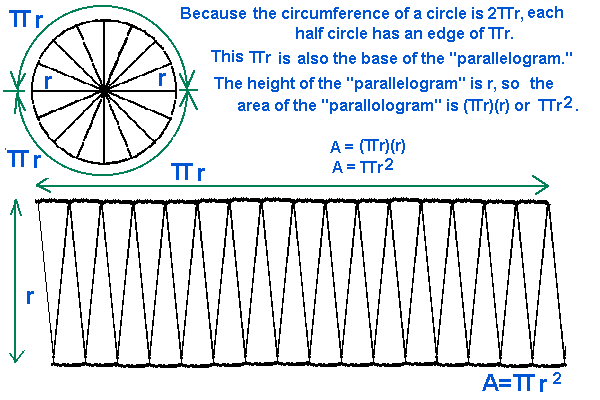Circle
- The illustration above shows in symbols and graphically that a circle cut in
pie-shaped pieces and rearranged, may be treated as a parallelogram for purposes of computing its area.
-
- To graphically see this transformation, look at in
sequence, the circle divided in half, then in quarters, then
in eighths, then in sixteenths, then in
thirty-secondths.
-
- If this process were to continue, cutting the area into smaller pie-shaped pieces, each
piece would still have the same height, the original radius of the circle, and though each curved edge would become
smaller in length, the curved edges placed on the base would be half of the curved edges of the circle,
 r. r. -
- Stated again in slightly different words: Since the circumference of a circle of radius r is 2
 r, each half-circle has a perimeter or curved length of r, each half-circle has a perimeter or curved length of
 r. r. -
- The radius r, and half the circumference,
 r, are the height and length of a "parallelogram." Since the area a parallelogram is
(base)x(height) the area of the circle is ( r, are the height and length of a "parallelogram." Since the area a parallelogram is
(base)x(height) the area of the circle is (
 r)x(r) or r)x(r) or
 r2. r2. -
- Stated again just in symbols:
- A= bh
- A= r(
 r) r)
- A=
 r2 r2 -
- HERE
is a large circle marked to be divided into 64ths. It is left to the reader to make the whole, halved, quartered, eighthed,
sixteenthed, 32thed, and 64thed copies of this image then to cut, rearrange, and tape the pieces together to make the
set of manipulatives which show the transformation from a circle of unknown area to a "parallelogram" in which the
area may be computed to be
 r2. It is worth the time to create the set needed for the
transformation. The manipulatives provide a powerful and simple way to explain a
complex fact. r2. It is worth the time to create the set needed for the
transformation. The manipulatives provide a powerful and simple way to explain a
complex fact.
|







